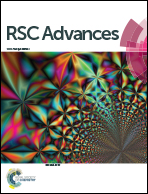Synthesis of silicone elastomers containing trifluoropropyl groups and their use in dielectric elastomer transducers†
Abstract
Vinyl end-functionalized polysiloxanes Px containing varying mol% of trifluoropropyl groups (x) were prepared starting from 1,3,5-tris(3,3,3-trifluoropropyl)-1,3,5-trimethylcyclotrisiloxane (F3) and octamethylcyclotetrasiloxane (D4) via anionic polymerization in the presence of tetramethylammonium hydroxide (TMAH) and 1,3-divinyl-1,1,3,3-tetramethyldisiloxane end-capping reagent. Their structures were determined by 1H NMR spectroscopy and their molecular weights and distributions were measured by GPC. The various Px were cross-linked in thin films via hydrosilylation of the vinyl groups with tetrakis(dimethylsiloxy)silane cross-linker in the presence of Karstedt catalyst. The mechanical, dielectric and electromechanical properties of the prepared films were investigated. An increase in the permittivity (ε′) with increasing content of polar trifluoropropyl groups was observed with a maximum value of ε′ = 6.4 for P58(0). A maximum lateral actuation strain of 5.4% at an electric field as low as 7.8 V μm−1 was measured for a material prepared by cross-linking P53.


 Please wait while we load your content...
Please wait while we load your content...